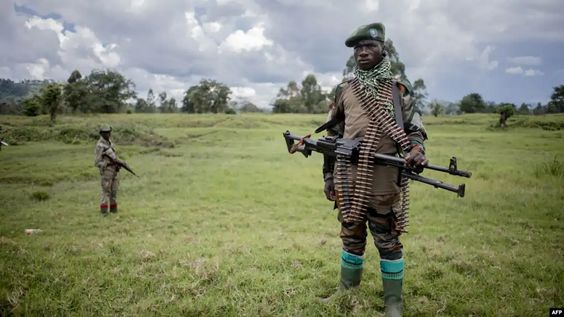Africa
Congo Militias Engage M23 Rebels in Battle

From a hill in eastern Congo, warlord Janvier Karairi gives orders to his troops as they fight the feared M23 rebel group.
The self-declared lieutenant general is in charge of a coalition that was put together to stop the M23. This coalition includes a militia called the Patriotic Alliance for a Free and Independent Congo (APCLS), which is mostly made up of fighters from the Hunde ethnic group.
In his operational headquarters, a thatched house in the Kitshanga region of North Kivu province, Karairi, 60, told AFP reporters that the APCLS and other armed groups joined forces “to resist the invader.”
Karairi, who wears a commando uniform, has lived in the bush for more than 25 years. In 2012, he fought with the M23 for a while.
In the dangerous east of the DRC, there are still a lot of armed groups, including the Tutsi-led M23. Many of these groups are the result of two terrible wars in the late 20th century.
That year, the M23 briefly held the provincial capital of Goma before being routed again in 2013.
In late 2021, it started fighting again, accusing the Congolese government of breaking a promise to incorporate its fighters into the army.
The M23 recently took control of some Rutshuru land near the border with Uganda and the border with Rwanda.
The rebels, who are currently located approximately 20 kilometers (12 miles) north of Goma and have advanced farther west toward Masisi, Karairi’s stronghold, are allegedly supported by Congo’s neighbor Rwanda.
Since his group controlled a big part of the land, the militia leader, who had been in battle before, decided to take up arms again against his old enemies.
In between phone calls to his troops on the ground, Karairi declared at his headquarters, “We continue to safeguard the populace.” Every time he talks, there is a pause.
Heritier Ndagendange, who had just arrived from Goma with a large red sack that another militiaman was carrying on his head to present to the commander, was with the seasoned fighter.
Ndagendange said that it was full of bullets that he had brought from Goma after stopping at several checkpoints manned by security forces.
“We can locate firearms easily since we are rebels. “Regardless, the government offers us no assistance,” said Karairi.
He said that the hundreds of his fighters are unpaid volunteers who share the same passion for warfare. “When we complete the job, our country will compensate us,” he stated.
Baseme, a 25-year-old soldier under his leadership, vowed his allegiance to his country with pride. His 23-year-old companion, Mwisha, claimed that the reason he joined the movement was “to resist the aggressors, Rwanda.”
An APCLS official said that the M23 was able to move quickly because the army had left some important routes.
Ndagendange says that Congolese army officers “betrayed” the cause, so the APCLS had to step in and stop the M23.
In a study released in October, Human Rights Watch (HRW) said that the Congolese army was working with armed groups, some of which are suspected of violating human rights, to fight the M23.
The Democratic Forces for the Liberation of Rwanda are one of them. This group, which is primarily Hutu, included some participants in the 1994 Rwandan genocide against the Tutsis.
HRW says that in May, the leaders of several armed Congolese groups, including Karairi’s APCLS, got together to form a “patriotic” alliance.
The army and the APCLS both say that they do not fight with these militias.
But because there were so many armed men on the streets of Kitshanga, some in military uniform and some in civilian clothes, a young telephone saleswoman named Muhoza said she could no longer tell them apart.
“You cannot tell who is who here. “With all these armed gangs, we are constantly in terror,” she muttered.
Two young Hunde villagers said they felt safe when they came back from the farms after the APCLS had arrived in their village.
But a Tutsi woman in Goma said that “General Janvier” and his young fighters forced her to leave Kitshanga.
